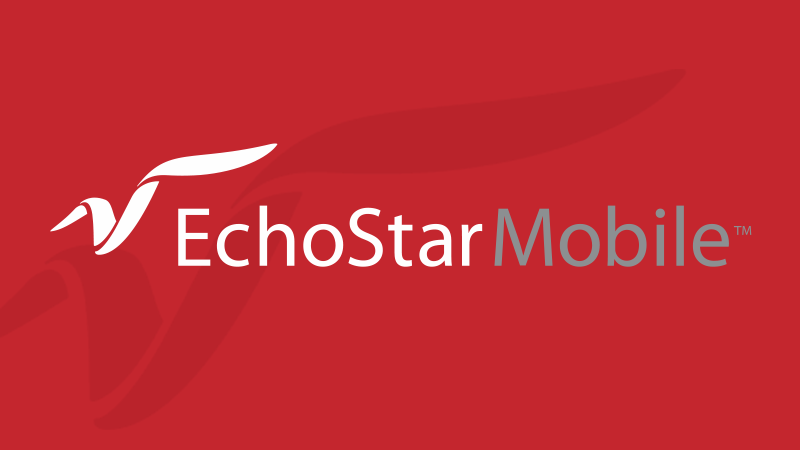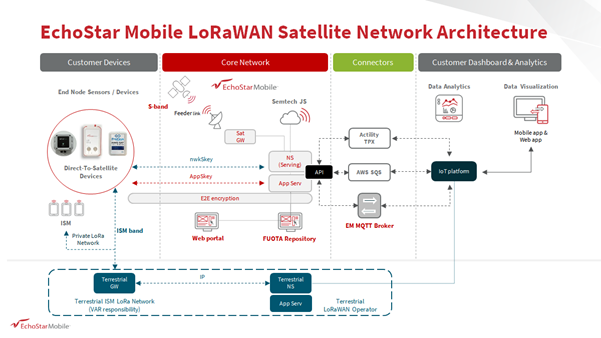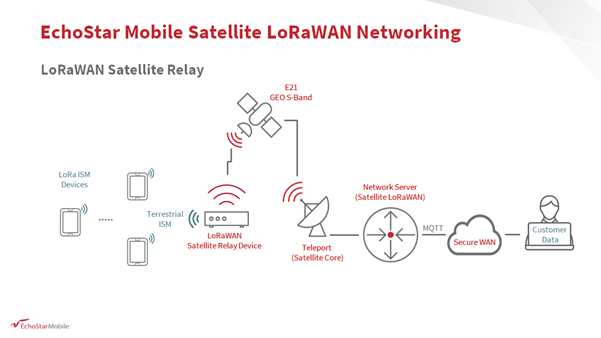
EchoStar Mobile’s Product and Services Roadmap for Delivering Seamless IoT Connectivity
In mid-2022, EchoStar Mobile launched its pan-European LoRa®-enabled Internet of Things (IoT) network, recently branded as Maxxive IoT. As a first-of-its-kind technology, it provides direct-to-satellite IoT connectivity in a licensed spectrum (S-band). This innovative network solution marked the beginning of EchoStar Mobile’s new product and service roadmap, which has the goal of enabling a seamless global IoT ecosystem.
Since the launch, EchoStar Mobile has continued to push the boundaries of connectivity, releasing updates to its solution and implementing strategies to optimise its functionalities and enhance customer experience.
In this blog, we take an in-depth look at EchoStar Mobile’s product and services roadmap and how it has made significant strides in making the integration of direct-to-satellite IoT connectivity straightforward and attractive for those using terrestrial IoT solutions. We review the timeline of Maxxive IoT, from the solution’s initiation and launch to what it offers now and what EchoStar Mobile has planned for the future.
Exploring Direct-to-Satellite Potential with The Early Adopter Program
In May 2022, EchoStar Mobile initiated an Early Adopter Program to prototype its groundbreaking pan-European LoRa®-enabled IoT network (Maxxive IoT). This program provided selected participants with early access to the satellite-enabled IoT network solution, allowing them to test its capabilities in real-world scenarios. Key applications included utility infrastructure monitoring, remote soil data collection, water meter installations, and personal safety tracking.
By adapting the standardised LoRaWAN® protocol on satellite, the Early Adopter Program demonstrated the potential for real-time, bi-directional connectivity for low-powered devices across Europe in areas where terrestrial networks are limited or unavailable. Its EM2050 OEM module, integrated with Semtech’s LR1120 chipset, leveraged EchoStar XXI geostationary satellite to provide this connectivity. This innovative approach aimed to unlock massive IoT capabilities, demonstrating how satellite coverage could enhance data collection and management for remote and mobile IoT applications.
EchoStar Mobile designed the program to gather critical feedback from these initial users, ensuring the network’s features met market demands and operational needs. This iterative process was essential for refining the service before its official commercial launch, ultimately offering a robust and reliable IoT connectivity solution across Europe. The Early Adopter Program highlighted EchoStar Mobile’s commitment to innovation and user-driven development in the IoT sector.
A Successful Commercial Launch: How Maxxive IoT Achieves the Goal of Expanding IoT Opportunities
Following a successful Early Adopter Program, in November 2022, EchoStar Mobile announced the commercial availability of its pan-European LoRa®-enabled IoT Network, Maxxive IoT. EchoStar Mobile uses a wholesale commercial model that empowers partners and value-added resellers (VAR), such as device manufacturers, OEMs and system integrators, to package end-to-end solutions that enhance existing IoT investments. By adapting the standardised LoRaWAN® protocol, EchoStar Mobile has made the integration of satellite into these existing terrestrial IoT solutions straightforward and cost-effective. The key difference is that, unlike its terrestrial counterpart, which uses an unlicensed channel, Maxxive IoT uses EchoStar’s licensed multi-channels for its IoT connectivity.
By integrating this direct-to-satellite solution into terrestrial IoT services, EchoStar Mobile can provide partners and their end customers with seamless, resilient connectivity for low-powered devices across all of Europe.
The key features of Maxxive IoT, at the time of first commercial release in November 2022, included:
- Network server carrier-grade platform with high reliability
- Compatibility with LoRaWAN® protocol
- LoRaWAN® specification Class A device (where uplink transmissions are followed by two short receive windows for downlink messages.)
- Over-the-air device activation with secure key
- Multi-band radio:
- Satellite on S-band spectrum
- Terrestrial on ISM (EU868, US915)
- Data encryption – Advanced Encryption Standard (AES) 128 bits
- Uplink and downlink LoRa® modulation
- Frame deduplication based on best signal-to-noise ratio (SNR)
- Integrated with AWS Cloud
With these features, Maxxive IoT offers the following benefits:
Real-time connectivity: The EM2050 module enables immediate data transmission and reception, allowing for timely decision-making and operational adjustments.
Dual-mode capability: The EM2050 module can transmit and receive LoRa® signals on licensed 2GHz satellite S-band and terrestrial sub-GHz EU/US ISM bands, switching to the appropriate network, using parameters set up in intelligent software within the device. The dual mode feature enables seamless coverage optimising connectivity and cost.
Bi-directional communication: The module also supports two-way data flow, enabling not only data collection but also remote command and control of connected devices.
Standardised technology: EchoStar Mobile selected LoRa® technology for Maxxive IoT because it was an existing modulation that required no specific development and adhered to the standardised LoRaWAN® specifications endorsed by the ITU as a global standard for LPWAN. This approach makes it easier to achieve interoperability between satellite and terrestrial ecosystems.
Wide coverage: Harnessing the EchoStar XXI geostationary satellite, Maxxive IoT offers ubiquitous coverage across numerous countries, removing the need for multiple network subscriptions and ensuring consistent and reliable connectivity for IoT applications regardless of geographic location.
Low-power consumption: LoRa® technology is designed for low-power use, allowing battery-operated devices to function efficiently over long periods. The low-power consumption of Class A devices is achieved as the device is in sleep mode when not in use. With optimised energy consumption and less charging required, maintenance and operational costs are notably reduced. This capability is particularly significant for devices in remote or hard-to-reach areas or when numerous devices are deployed.
No additional infrastructure needed: The EM2050 module enables direct-to-satellite connectivity, eliminating the need for extensive ground-based infrastructure and making it ideal for isolated areas or applications on the move.
Plug-and-play device: The EM2050 module was designed to be as user-friendly as possible, using zero-touch provisioning to activate the device easily.
Real-world testing: EchoStar Mobile offers the EM2050-EVK Evaluation Kit to allow system integrators to prototype and test their IoT devices with Maxxive IoT.
Robust security: AES 128 bit encryption ensures data confidentiality and integrity at a level widely regarded as secure for sensitive information and data privacy.
These features made the Maxxive IoT network an accessible and viable solution for applications in industries such as agriculture, energy, utilities, environmental monitoring, transport and logistics, enabling efficient, scalable, and reliable massive IoT deployments.
A Drive for Continuous Improvement: 2023 Updates to Maxxive IoT
In 2023, EchoStar Mobile implemented the following updates to Maxxive IoT to enhance its functionality and user experience:
Smart ADR for satellite IoT
Adaptive Data Rate (ADR) is a mechanism that optimises data rates, airtime, and energy consumption. Leveraged in the Maxxive IoT solution, it seeks to use the best channel and speed to minimise power use when obtaining a reliable satellite link. For IoT, this ability is particularly valuable as devices are typically battery powered. Thus, using Smart ADR in combination with the low-power usage of LoRaWAN ensures a battery life of up to 5-7 years.
ABP device activation
Using activation by personalisation (ABP), IoT devices can be activated on the network by pre-configuring them with necessary security keys and network parameters. This process simplifies deployment and ensures secure, immediate connectivity.
UL LoRa®-FHSS modulation
Uplink (UL) LoRa®-Frequency Hopping Spread Spectrum (FHSS) modulation further enhances communication reliability and resilience from the initial LoRaWAN® standard. It spreads data transmissions over multiple frequencies, reducing interference and improving data integrity, particularly in challenging environments. This functionality significantly benefits high-traffic scenarios, such as those for massive IoT that cover a vast area and connect to thousands of devices.
Class C device
By encompassing LoRaWAN® protocol Class C devices, Maxxive IoT can cater to more complex IoT scenarios. By offering near-continuous receive windows, it allows receipt of downlink messages at any time except when transmitting. This ‘always listening’ capability supports real-time interaction with the device, which is ideal for when immediate action is required, e.g., wildfires, pipeline monitoring, etc.
Multicast support engine
This feature enables the network to simultaneously send a single message to multiple devices, e.g., turning on and off the streetlights in a smart city. Multicast is valuable for processes like firmware updates, command and control, and synchronised operations across numerous devices.
Firmware Update Over the Air (FUOTA) engine
FUOTA allows IoT devices to receive firmware updates remotely via the network. This capability is crucial for maintaining and upgrading device software without the need for physical access. It helps ensure devices stay secure and functional for longer, reducing maintenance costs and downtime.
FUOTA is a hugely valuable capability when thousands of devices are located in remote areas and require an update. Making this update to each one in person would be a timely and costly operation. FUOTA eliminates this need by sending several compact files over the network to the fleet of devices to install the updated firmware.
Access to EchoStar’s licensed satellite spectrum and dedicated capacity on the channel also ensures these updates can be completed efficiently and securely. On the contrary, with unlicensed networks, carrying out these updates over the air presents many more challenges as this dedicated capacity may not be available.
Maintaining Simplicity for the Customer
One key aim of these developments is to enhance the user experience. Therefore, the complexity of these new functionalities is kept within the Core Network, managed by EchoStar Mobile, and in the sensor device. For the customer, the solution remains plug and play, meaning they can benefit from these improvements without the need for specialised expertise.
Enhancing The User Experience: Maxxive IoT in 2024
Eighteen months after the commercial release of Maxxive IoT, EchoStar Mobile has continued to evolve its capabilities, driving enhanced performance, accessibility, and ease with its updates.
The 2024 Release offers the following new features with the solution:
External API for Multicast
With an external API for multicast, third-party applications can now send multicast messages to multiple IoT devices simultaneously, also having control over which devices need to receive the message. To carry out this process, users must create a Multicast Group with a downlink (DL) message in JSON (JavaScript Object Notation) format and of a maximum length of 50 bytes.
EchoStar Mobile then manages the process, checking the DL format and generating a standardised encryption for the multicast. An appointment with the devices is then made so they are active and ready to receive the message. Feedback on the session is provided to the user from the network server.
Having an external API for multicast that enables users to access the multicast capabilities provides greater user control, improving efficiencies and flexibility in the process.
External API for FUOTA
The external API for FUOTA offers user benefits similar to those of the multicast. Users share the firmware file with EchoStar Mobile to initiate this procedure, identifying which devices require the update. EchoStar Mobile then fully manages the FUOTA session via a fully transparent process. It creates the appointment with the device and manages the file transfer. The success of the FUOTA is confirmed with every device. New FUOTA sessions can be started if required.
The external API simplifies remote firmware updates, while management via EchoStar Mobile minimises the risk and helps to ensure devices are kept secure and up to date.
MQTT Connector for External Integration
EchoStar Mobile’s MQTT Broker acts as a standard Connector to facilitate seamless communication between external systems and its Maxxive IoT network.
Message Queuing Telemetry Transport (MQTT) is a lightweight, publish-subscribe protocol that minimises insertion delay, enabling near real-time downlink messaging. Used as a Connector in EchoStar Mobile’s Reference Network Architecture, this functionality leverages unique Customer and Application IDs obtained from the EchoStar Mobile web portal to organise data exchange, enabling devices to publish and subscribe to the required topics efficiently.
At the Connector level, EchoStar Mobile’s MQTT Broker can distribute the information received from the devices to the required MQTT clients. Depending on the requirement, this could be one or several clients. This capability simplifies the use of IoT ecosystems, enhancing operational efficiencies and scalability, with a few devices serving many customers with the required information.
Interworking with Actility’s Roaming Hub
Interworking with Actility’s Roaming Hub enables seamless connectivity between Maxxive IoT’s satellite S-band service and terrestrial networks. The integration involves the ThingPark Exchange Roaming Hub, which acts as a Connector from EchoStar’s satellite network to Actility’s LoRaWAN® suite and supports both uplink (UL) and downlink (DL) communications. With this approach, customers already using Actility’s IoT platform for their terrestrial requirements can simply extend their solution to incorporate EchoStar Mobile’s satellite connectivity.
When seeking to send and receive messages over satellite, deployed physical sensor devices send and receive data directly to the EchoStar Mobile’s Core Network. The message is then relayed to the ThingPark Exchange Roaming Hub, where terrestrial virtual devices (vDevEUI), mapped one-to-one with the actual devices, provide the data to the user’s network server. This approach enhances interoperability while simplifying access to data via satellite by using customers’ existing terrestrial solution.
Satellite Relay
EchoStar Mobile’s Satellite Relay is a Satellite IoT hub designed to aggregate data from 16 to 32 LoRaWAN® ISM devices and transmit this data directly to a satellite via the S-band. The Relay is a helpful tool in situations where direct-to-satellite connection is not possible. Use case examples include indoor sensors for alarm monitoring in remote areas, submetering in energy and oil and gas sectors, and cold chain logistics tracking. Additionally, it facilitates the use of sensors that lack a direct line of sight with the sky, expanding the deployment possibilities for indoor sensors in remote areas.
The Relay is not a traditional gateway but a battery-operated device that collects data from the sensors via the unlicensed, standard LoRaWAN® channel. By placing the Relay in the line of sight of the sky, it then can communicate this information to the satellite.
In addition to providing a simple method for extending satellite IoT connectivity in scenarios where a direct link is challenging, it also offers a convenient and cost-effective way for customers with existing and well-established LoRaWAN® solutions to access direct-to-satellite connectivity. Using a Relay removes the complexity, time and expenses of overhauling their complete architecture, offering a straightforward and efficient go-to-market solution using their existing ecosystem.
Provisioning platform (customer portal)
The provisioning platform provides users with a web-based interface where they can manage their IoT devices, configure network settings, and monitor performance.
A provisioning platform provides a user-friendly method for device management, streamlining the deployment and maintenance of IoT solutions and improving operational efficiency through centralised control.
The Evolution of the EM2050 Module
The EM2050 OEM module forms a key part of the Maxxive IoT network solution, enabling dual-mode transmission on both S-band satellite and sub-GHz terrestrial ISM bands.
Introduced in 2022, it is the initial version of this technology, ensuring short-term availability with thousands in stock. In Q4 of 2024, the evolved EM2060 module will address component obsolescence. However, it will be fully form, fit, and function (FFF) compatible with the EM2050, thus having no impact on existing devices, architecture or operations. Furthermore, in Q4 2024 EchoStar Mobile will release the EM2060 reference design for large volumes/OEM production.
Looking ahead to 2026 and beyond, EchoStar Mobile will introduce a new generation module with higher integration and new functionality to enhance IoT connectivity capabilities further.
Throughout these phases of development, EchoStar Mobile will ensure continuity in the solution offered while evolving to deliver improvements.
Future Prospects for Direct-To-Satellite Connectivity via Maxxive IoT
Just a few years ago, direct connectivity to satellite was an unexplored idea, which many believed was unfeasible. EchoStar Mobile has shown that it is not just a possibility but a significant opportunity that can benefit a wide range of industries. It has made significant strides in advancing IoT connectivity with its Maxxive IoT network. The developments it has introduced since 2022 and its continuing advances make the idea of direct-to-satellite a proven concept that is affordable, uncomplicated, and easy to integrate into existing terrestrial solutions.
As we look to the future, EchoStar Mobile is poised to expand its capabilities and offerings further. The integration of external APIs for multicast and FUOTA, interworking with Actility’s Roaming Hub, and the deployment of satellite relays all point to a comprehensive, robust IoT ecosystem. These advancements not only enhance current functionalities but also lay the groundwork for future IoT applications that will benefit from even greater connectivity and operational efficiency.
In conclusion, EchoStar Mobile’s roadmap reflects a clear vision of a connected world where IoT devices operate seamlessly across diverse environments. By continually pushing the boundaries of technology and addressing the evolving needs of its users, EchoStar Mobile aims to significantly contribute to the progress of the IoT ecosystem, driving innovation, creating value for its customers and positioning itself as a key player in this fast-evolving field.
To learn more about EchoStar Mobile’s Maxxive IoT solution and how it can support your connectivity requirements, please get in touch with our team.




